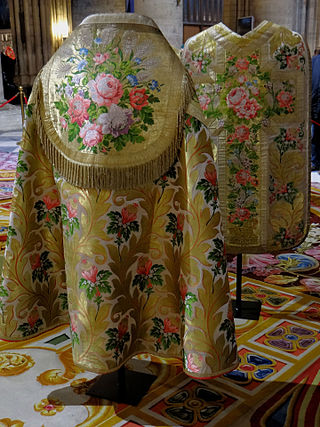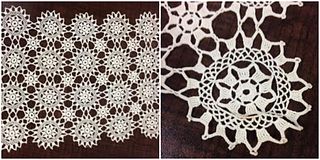
Lace is a delicate fabric made of yarn or thread in an open weblike pattern, made by machine or by hand. Generally, lace is divided into two main categories, needlelace and bobbin lace, although there are other types of lace, such as knitted or crocheted lace. Other laces such as these are considered as a category of their specific craft. Knitted lace, therefore, is an example of knitting. This article considers both needle lace and bobbin lace.
Needlepoint is a type of canvas work, a form of embroidery in which yarn is stitched through a stiff open weave canvas. Traditionally needlepoint designs completely cover the canvas. Although needlepoint may be worked in a variety of stitches, many needlepoint designs use only a simple tent stitch and rely upon color changes in the yarn to construct the pattern. Needlepoint is the oldest form of canvas work.

A tunic is a garment for the body, usually simple in style, reaching from the shoulders to a length somewhere between the hips and the knees. The name derives from the Latin tunica, the basic garment worn by both men and women in Ancient Rome, which in turn was based on earlier Greek garments that covered wearers' waists.

Zari is an even thread traditionally made of fine gold or silver used in traditional Indian, Bangladeshi and Pakistani garments, especially as brocade in saris etc. This thread is woven into fabrics, primarily silk, to make intricate patterns and elaborate designs of embroidery called zardozi. Zari was popularised during the Moghul era; the port of Surat was linked to the Meccan pilgrimage route which served as a major factor for re-introducing this ancient craft in India.

An evening gown, evening dress or gown is a long dress usually worn at formal occasions. The drop ranges from ballerina, tea, to full-length. Such gowns are typically worn with evening gloves. Evening gowns are usually made of luxurious fabrics such as chiffon, velvet, satin, or organza. Silk is a popular fibre for many evening gowns. Although the terms are used interchangeably, ball gowns and evening gowns differ in that a ball gown will always have a full skirt and a fitted bodice, while an evening gown can be any silhouette—sheath, mermaid, fit and flare, A-line, or trumpet-shaped—and may have straps, halters or even sleeves.

Gimp is a narrow ornamental trim used in sewing or embroidery. It is made of silk, wool, polyester, or cotton and is often stiffened with metallic wire or coarse cord running through it. Gimp is used as trimming for dresses, curtains, furniture, etc. Originally the term referred to a thread with a cord or wire in the center, but now is mainly used for a trimming braided or twisted from this thread. Sometimes gimp is covered in beads or spangles.

For woven textiles, grain refers to the orientation of the weft and warp threads. The three named grains are straight grain, cross grain, and the bias grain. In sewing, a pattern piece can be cut from fabric in any orientation, and the chosen grain or orientation will affect the way the fabric hangs and stretches and thus the fit of a garment. Generally speaking a piece is said to be cut on a particular grain when the longest part of the pattern or the main seams of the finished piece are aligned with that grain. Non-woven materials such as felt, interfacing or leather do not have a grain.

1850s fashion in Western and Western-influenced clothing is characterized by an increase in the width of women's skirts supported by crinolines or hoops, the mass production of sewing machines, and the beginnings of dress reform. Masculine styles began to originate more in London, while female fashions originated almost exclusively in Paris.

Fashion in the period 1550–1600 in European clothing was characterized by increased opulence. Contrasting fabrics, slashes, embroidery, applied trims, and other forms of surface ornamentation remained prominent. The wide silhouette, conical for women with breadth at the hips and broadly square for men with width at the shoulders had reached its peak in the 1530s, and by mid-century a tall, narrow line with a V-lined waist was back in fashion. Sleeves and women's skirts then began to widen again, with emphasis at the shoulder that would continue into the next century. The characteristic garment of the period was the ruff, which began as a modest ruffle attached to the neckband of a shirt or smock and grew into a separate garment of fine linen, trimmed with lace, cutwork or embroidery, and shaped into crisp, precise folds with starch and heated irons.

Kumihimo is a traditional Japanese artform of making braids and cords. Literally meaning "gathered threads", kumihimo are made by interlacing reels of yarn, commonly silk, with the use of traditional, specialised looms – either a marudai or a takadai (高台).

A pelisse was originally a short fur-trimmed jacket which hussar light-cavalry soldiers from the 17th century onwards usually wore hanging loose over the left shoulder, ostensibly to prevent sword cuts. The name also came to refer to a fashionable style of woman's coat-like garment worn in the early-19th century.
The manufacture of textiles is one of the oldest of human technologies. To make textiles, the first requirement is a source of fiber from which a yarn can be made, primarily by spinning. The yarn is processed by knitting or weaving, which turns yarn into cloth. The machine used for weaving is the loom. For decoration, the process of colouring yarn or the finished material is dyeing. For more information of the various steps, see textile manufacturing.

Brocade is a class of richly decorative shuttle-woven fabrics, often made in colored silks and sometimes with gold and silver threads. The name, related to the same root as the word "broccoli", comes from Italian broccato meaning "embossed cloth", originally past participle of the verb broccare "to stud, set with nails", from brocco, "small nail", from Latin broccus, "projecting, pointed".

Passementerie or passementarie is the art of making elaborate trimmings or edgings of applied braid, gold or silver cord, embroidery, colored silk, or beads for clothing or furnishings.

Soutache, also known as Russia braid, is a narrow flat decorative braid, a type of galloon, used in the trimming of drapery or clothing. Soutache is created by weaving a decorative thread around and between two parallel cords and completely covering the cores; this produces a piece of trim with a braided or herringbone pattern. Often woven of metallic bullion thread, silk, or a blend of silk and wool, soutache began to be made of rayon and other synthetic fibers in the 20th century.
Galon, Gal-on, etc. may refer to:

Fingerloop braiding is a technique of making sturdy and decorative cords from threads. It is a type of braiding known as loop manipulation. The braid is made from loops of thread, attached at a central point, and the loops placed over the fingers and interlaced in different ways.

Croatian national costume, also called as Croatian traditional clothing or Croatian dress, refers to the traditional clothing worn by Croats living in Croatia, Bosnia and Herzegovina, Serbia, with smaller communities in Hungary, Austria, Montenegro, and Romania. Since today Croats wear Western-style clothing on a daily basis, the national costumes are most often worn with connection to special events and celebrations, mostly at ethnic festivals, religious holidays, weddings, and by dancing groups who dance the traditional Croatian kolo, or circle dance.

Greek lace is considered one of the earliest forms of all lace. Some types of Greek lace include reticella, Roman lace, cutwork, Venetian guipure, and Greek point lace

Ipswich lace is a historical fashion accessory, the only known American hand-made bobbin lace to be commercially produced. Centered in the coastal town of Ipswich, Massachusetts north of Boston, a community of lacemaking arose in the 18th century. Puritan settlers to the area likely made and wore lace as early as 1634, because Sumptuary laws from the early colonial records indicate this activity. Earliest known records of the commercial production indicate that lace produced by local women was used to barter for goods in the 1760s, as denoted by ledger account books belonging to local merchants. These laces were sold in the region from Boston to Maine.




















